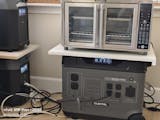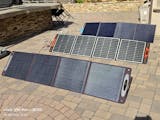What Size Generator for 400 Amp Service
Choosing the right size of the generator to match the 400-amp service is advisable because of the flow of electricity and power requirements in the properties. Having a correctly sized generator goes further in ensuring all necessary power requirements have been addressed without a chance of being overloaded, assuring homeowners and businesses.
In the current world scenario where there are frequent power mishaps, having a good generator is very crucial. It enables you to carry out some basic activities like heating or cooling and even preserving foods through refrigeration in the event of a power failure. In addition to determining the total amount of power load, we will help you pick the right generator based on your power requirements.
Understanding Power Requirements for a 400 Amp Service
A 400 amp service is mostly wanted in large residences, multi-unit structures, or industrial enterprises that demand more power. This level of service is useful for buildings that have many power-hungry appliances including HVAC, machinery, and flashy lighting systems.
It is important to calculate the total power load to arrive at the appropriate generator. This covers running wattage, which is the amount of power needed to sustain the operation of appliances, and starting wattage, which is additional power needed to initiate appliances with motors. These requirements aid in selecting a generator that is capable of supporting the electrical load without causing an overload situation.


Here are some properties that typically require 400 amp service :
- Large Homes:Residences comprise several rooms with central air conditioning systems, electric heaters, and many electric power-consuming appliances.
- Commercial Buildings:Offices, stores, and restaurants that use a large number of electronic devices and equipment.
- Industrial Facilities: Industrial buildings, such as factories, and warehouses where heavy equipment is employed, and enhanced power consumption is necessary.
Step-by-Step Guide to Determining Generator Size
1. Calculate the Total Power Load
To determine the generator size needed, follow these steps:
a. Identify All Devices and Appliances
This includes:
- Refrigerators
- Air conditioning units
- Water heaters
- Lighting fixtures
- Electronics (TVs, computers, and so on.)
- Heavy machinery (if applicable)
b. Find Power Requirements for Each Device
For each device calculate the power needs of the device depending on both the running watts and the starting power needed. Here’s a breakdown of common household devices:
| Device | Running Watts | Starting watts |
|
Refrigerator |
800 |
1200 |
|
Central Air Conditioner |
3000 |
4500 |
|
Water Heater |
4000 |
6000 |
|
Lights and Outlets |
2000 |
N/A |
|
Microwave |
1000 |
2000 |
c. Example Calculation of Total Power Load
Using the above table, let’s calculate the total running and starting loads for a typical household:
Total Running Load:
- Refrigerator:800 watts
- Central AC:3000 watts
- Water Heater:4000 watts
- Lights and Outlets:The power that is required in the kitchen is about 2000 watts.
- Microwave:1000 watts
Total Running Load = Power packed + Air conditioner load + Washing and refrigeration load + Light load + Fan load = 10800 watts
Total Starting Load:
- Refrigerator:1200 watts
- Central AC:4500 watts
- Water Heater:6000 watts
- Microwave:2000 watts
Total Starting Load = 1200 + 4500 + 6000 + 2000 = 13700 watts
2. Consider Future Expansion and Safety Margins
In determining the generator size it is wise to consider the future electrical requirements. Anything from new appliances or devices that you may plan on introducing shortly should also be taken into consideration. The overall wattage is also taken and an addition of 20% acts as a buffer in case of any extra loads or extra appliances to be connected.
Safety Margin Calculation:
- Total Running Load:10800 W.
- Safety Margin (20%):10800 × 0. 20 = 2160 watts
Adjusted total running load = 10,800 + 2,160 = 12,960 watt
3. Convert Amps to Watts
To convert amps to watts, use the following formula:
Watts=Amps×Volts
Watts=Amps×Volts
For a 400 amp service at 240 volts:
400 amps×240 volts = 96,000 watts
400 amps×240 volts = 96,000 watts
This calculation indicates that a generator would need to support a maximum of 96,000 watts to handle the full capacity of a 400-amp service.
a. Example Calculation for Typical Household
Let’s consider a household with a 400 amp service and calculate the total power load based on common devices:
● Common Household Devices
| Device | Running Watts | Starting Watts |
|
Refrigerator |
800 |
1200 |
|
Central Air Conditioner |
3000 |
4500 |
|
Water Heater |
4000 |
6000 |
|
Lights and Outlets |
2000 |
N/A |
|
Microwave |
1000 |
2000 |
|
Washer/Dryer |
3000 |
6000 |
● Global Cumulative and Initiated Currents
Total Running Load:
- Refrigerator: 800 watts
- Central AC: 3000 watts
- Water Heater: 4000 watts
- Lights and Outlets: 2000 watts.
- Microwave: 1000 watts
- Washer/Dryer: 3000 watts
Total Running Load = 800+3000+4000+2000+1000+3000 = 13800 watts
Total Starting Load:
- Refrigerator: 1200 watts
- Central AC: 4500 watts
- Water Heater: 6000 watts
- Microwave: 2000 watts
- Washer/Dryer: 6000 watts
- Total Starting Load = 1200 + 4500 + 6000 + 2000 + 6000 = 19700 watts
Recommended Generator Size
For a normal residential home that receives a supply of 400 amps, it is advisable to use a generator of between 20000 and 30000 watts. Nevertheless, for more specific work that has to fit into a certain context, it’s better to address an electrician and a specialist in generators.
The catalog is fairly large and several models may suffice the power requirements of a 400-amp service. Here are three recommended models: Here are three recommended models:
Oukitel P5000 power station
The Oukitel P5000 is one powerful, compact, and highly portable power station that can fulfill high power requirements. With a constant power of 2200W and an accumulated energy capacity of 5120Wh, it can charge multiple appliances at a time.
This model is recommended for users who need a steady power source for something like a home backup or a camping trip. Some of the material aspects include multiple AC outlets, and multiple USB outlets making it convenient to charge different devices.
Oukitel BP2000
Oukitel BP2000 is a portable power station with 2048Wh battery capacity and a peak power of 2200W. It is portable due to the compact size and WITH several port options for charging different gadgets at once. This model to used for camping trips or other outdoor activities or as a power backup for the house. The above system also has a solar charge option, meaning the use of green energy in BP2000.
Oukitel P2001 Plus
The Oukitel P2001 Plus is a new device, derived from the Oukitel P2001 with the increased capacity being 2048Wh and the output power of 2400W. It has some additional features like supercharging to charge extremely fast and multiple output sockets to be suitable for use both at home and in outdoor activities. There is also a UPS mode in the P2001 Plus which guarantees instantaneous power switchover in the case of a power failure hence discrete power supply.
Other Power Solutions
Specifically, the large station generators are most suitable for the 400 amp services; however, it has other power products for smaller operations. Portable generators such as BP2000 and P2001 Plus can be regarded as fulfilling less demanding requirements since they offer mobility and easiness. These models are handy for camping and as an additional source of power for crucial items in case of a power outage such as for tailgating.
Let’s discuss a few benefits of portable power generators:
- Versatility:There are several uses for portable generators; outdoor job sites where construction equipment needs to be operated, or they can be used in homes in the event of a power outage.
- Ease of Use:Most of the portable generators are designed and have control panels that are easy to use and quick to set up for anyone.
- Cost-Effective:When speaking about power amounts, portable generators are more suitable for lower demand as compared to stand-by ones.
Conclusion
Deciding on the appropriate size of the generator to draw from a 400 amp service requires one to look at the total load, expansion, and safety margins. It is important to comprehend the power requirements of your home or commercial establishment to make a wise decision.
As power solution devices for different demands, there products such as the P5000, BP2000, and the P2001 Plus can be recommended. We hope this article helped determine what size generator is suitable for 400 Amp service.








































 Oukitel Solar
Extension Cable
Oukitel Solar
Extension Cable
















Dejar un comentario